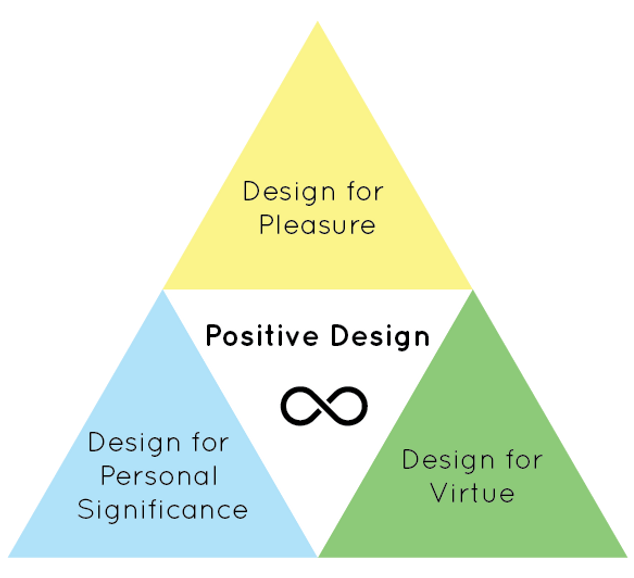Positive Design
How can design contribute to the field of positive psychology? How can we consciously and deliberately use design skills in contributing to the happiness of individuals and communities?
Positive design deals with answering those questions and focuses on research and development of solutions that increase people’s subjective well-being and thus happiness. The goal is to stimulate and enhance positive emotions and reduce negative ones. [1]
Happiness drives people to flourish—according to a research the performance of happy people can increase up to 12% whilst maintaining quality of work, but on the other hand performance can also lose up to 10% when people are unhappy. Therefore, that finding not only takes an important part when it comes to employee’s happiness and thus on productivity—subjective well-being plays a significant role in performance. And, of course, consumers are likely to value offered solutions/products better when they are happier, and vice versa when they are unhappy. Positive design is based on design theory and psychology. The latter is the science that focuses on understanding what makes people happy and what makes them flourish. Research has found that happiness is determined by three factors, and that two of these three determinants are possible to design for. [2]

Positive Design Framework [3]
Positive design enhances positive emotions and reduces negative ones. That can be achieved by engaging personal character strengths and weaknesses, and by taking on evidence-based opportunities and threats as measures for a scientific design approach rather than a single designer’s perception. It is about providing solutions that helps people satisfy their growth-needs whilst taking into account their deficiency-needs. The Positive Design framework offers an overview of possible design applications for happiness, consisting of 3 layers that can be designed:

Design for Pleasure
Here, the focus is on happiness, achieved by a person’s pleasures and derived from enhanced positive feelings or decreased negative feelings. There are four types of pleasures: physical, social, psychological, and ideological.
Design for Personal Significance
Design for Personal Significance is about personal goals and aspirations. A positive affect can also be gained from achieving and remembering goals and getting a sense of accomplishment from certain behaviors. The focus clearly is on an individual’s interpretation of what makes life worth living and having the freedom in doing so.
Design for Virtue
Virtuous behavior is about what is perceived as good and what is perceived as bad. “It is based on the proposition that there is an ideal mode of behavior, or a sense of excellence or perfection towards which one should strive, that leads to a virtuous life.” Correct translation of believes and values into design processes can be beneficial to people’s happiness.
Positive Design Ingredients [4]
Besides the above-mentioned framework in which one can apply positive strategic design, there is a set of ingredients of which the effect on someone’s happiness is proven to be successful. These ingredients are derived from research in positive psychology and act as important rules of thumb to incorporate in design and prevent obstruction.
Positive Emotion
Positive emotion is simply about feeling good. The focus is on gaining positive experiences by satisfying deficiency need to a pleasurable experience and satisfying growth need to an enjoyable experience.
Engagement
Engagement is about the activities an individual is engaging in. If one is acting in full envlolvement, that holistic sensation is called the flow state. The focus clearly is on challenging, fulfilling and interesting activities that captivate people to be fully engaged in the moment. Individual values and preferences have to be considered in this process.
Relationships
There is a causality between social relationships and health, thus that aspect plays an important role. People want are in need of authentic connection and social cohesion and reacquire emotional and physical interaction.
Meaning
Meaning defines understanding and making sense of ones existence and its impact on others—to have a purpose and goal to strive for.
Accomplishments
The positive effect form having goals can be enhanced by achievement of those goals. Interest, ability and perseverance are therefore important factors to consider.
Sources:
[1] https://www.positivestrategicdesign.com/positive-design
[2] https://issuu.com/delftinstituteofpositivedesign/docs/issuu
[3] ebda.
[4] ebda.